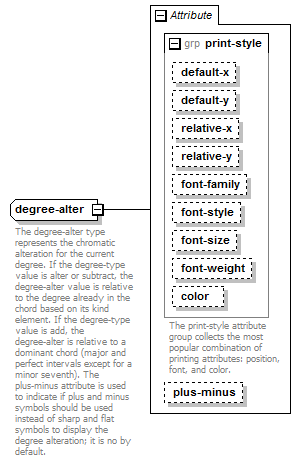degree-alter
The degree-alter type represents the chromatic alteration for the current degree. If the degree-type value is alter or subtract, the degree-alter value is relative to the degree already in the chord based on its kind element. If the degree-type value is add, the degree-alter is relative to a dominant chord (major and perfect intervals except for a minor seventh). The plus-minus attribute is used to indicate if plus and minus symbols should be used instead of sharp and flat symbols to display the degree alteration; it is no by default. |
Complex Type Information
Model

Attributes
| QName | Type | Fixed | Default | Use | Inheritable | Annotation |
|---|---|---|---|---|---|---|
| color | color | optional | ||||
| default-x | tenths | optional | ||||
| default-y | tenths | optional | ||||
| font-family | comma-separated-text | optional | ||||
| font-size | font-size | optional | ||||
| font-style | font-style | optional | ||||
| font-weight | font-weight | optional | ||||
| plus-minus | yes-no | optional | ||||
| relative-x | tenths | optional | ||||
| relative-y | tenths | optional |
Used By
| Element | degree/degree-alter |
Source
<xs:complexType name="degree-alter"> <xs:annotation> <xs:documentation>The degree-alter type represents the chromatic alteration for the current degree. If the degree-type value is alter or subtract, the degree-alter value is relative to the degree already in the chord based on its kind element. If the degree-type value is add, the degree-alter is relative to a dominant chord (major and perfect intervals except for a minor seventh). The plus-minus attribute is used to indicate if plus and minus symbols should be used instead of sharp and flat symbols to display the degree alteration; it is no by default.</xs:documentation> </xs:annotation> <xs:simpleContent> <xs:extension base="semitones"> <xs:attributeGroup ref="print-style"/> <xs:attribute name="plus-minus" type="yes-no"/> </xs:extension> </xs:simpleContent> </xs:complexType> |